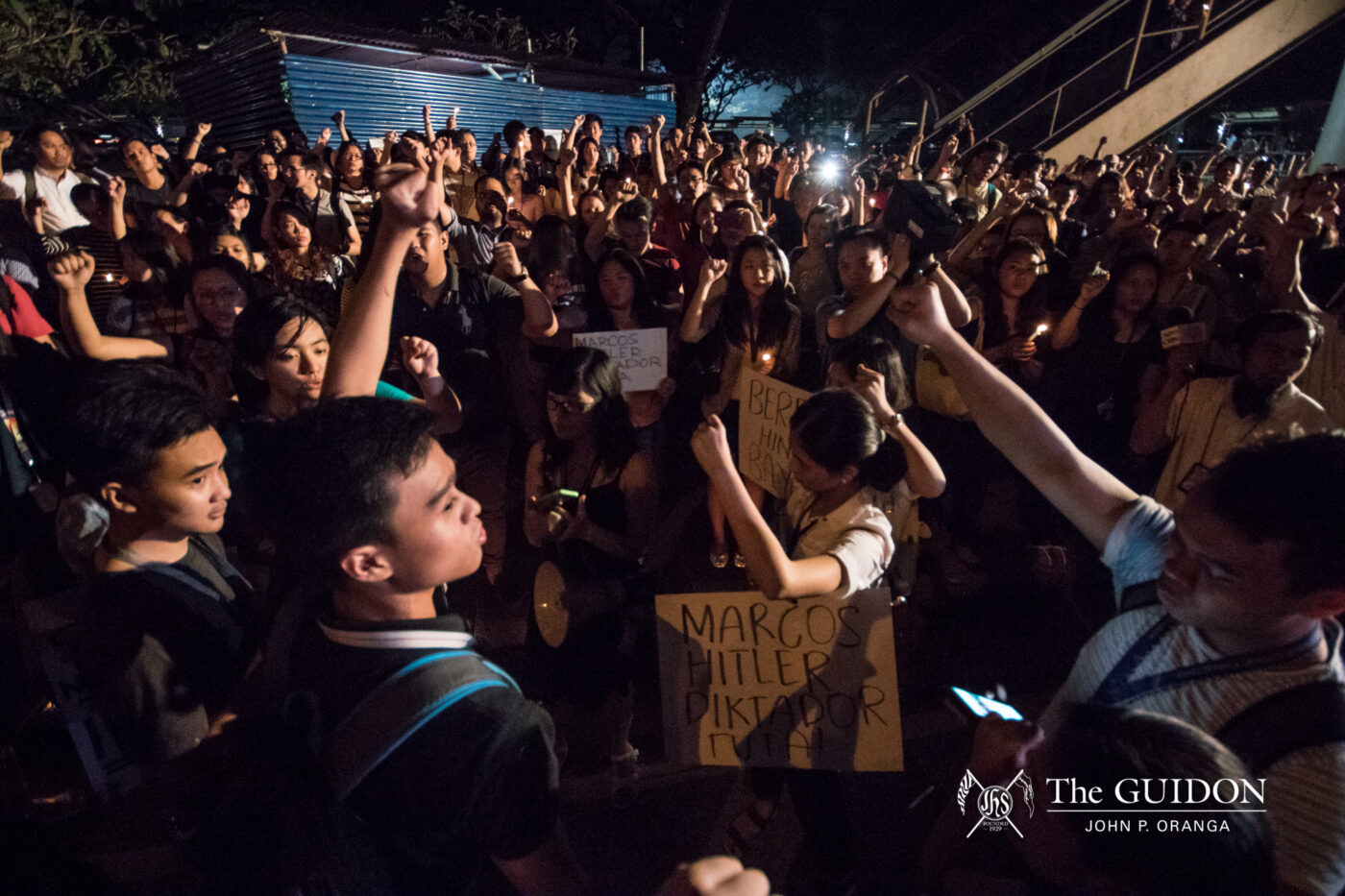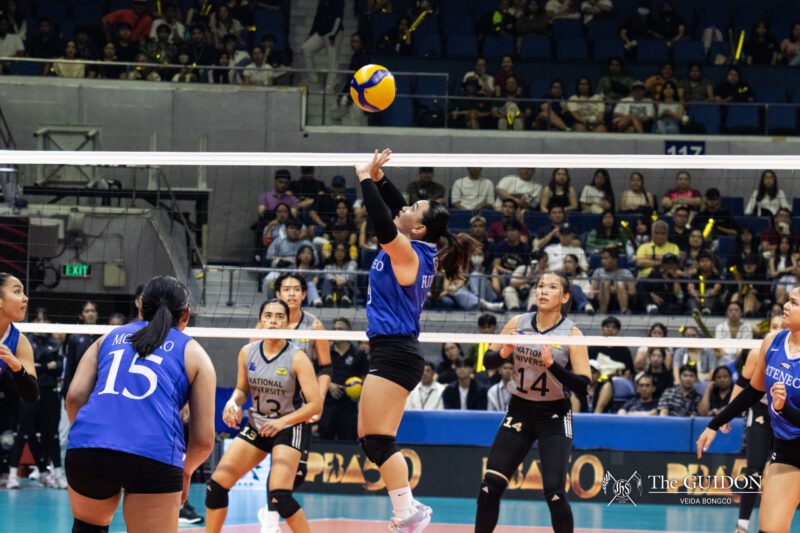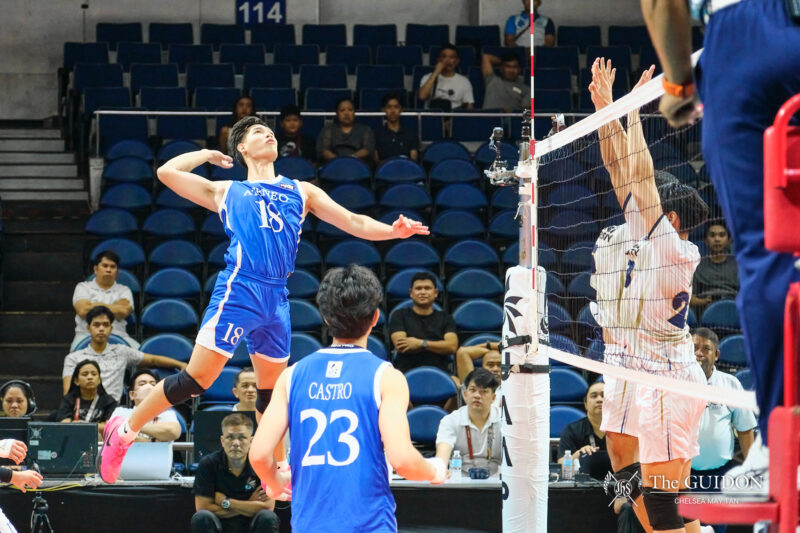AMID THE plague of historical distortion and a polarized sociopolitical landscape, commemorating the legacy of the 1986 EDSA People Power Revolution has become more challenging than ever. While the Revolution is considered a critical juncture in Philippine history, the contemporary Filipinos’ perspective on EDSA as a cornerstone of Philippine democracy has been dwindling. Many have been left frustrated and discontented with the country’s post-EDSA failure to alleviate the suffering of its citizens.
As a university that seeks to uphold the ideals of democracy, the Ateneo and its role as one of the leading institutions against Martial Law is under constant scrutiny. Now more than ever, such a contentious climate puts into question how Atenean activism has evolved alongside changing times.
On-the-ground
Ateneo students during the Revolution were seen putting themselves directly at the scene and immersing themselves in the spirit of activism. However, longtime activist, History Department Lecturer, and former Ateneo Martial Law Museum and Library (AMLML) Director Meynardo Mendoza, PhD, says that this was not the initial case, as many Ateneans needed convincing to join the struggle for change.
“Unlike ibang mga estudyante diyan… madaling ma-mobilize kasi. Pero ang Atenista kasi is the ‘thinking class.’ Hindi mo siya pwedeng madaliin,” Mendoza remarks.
(Ateneans are unlike other students who are easy to mobilize. However, the Atenean is regarded as the “thinking class.” You cannot hurry them.)
For Mendoza, his own experience with EDSA began when he was organizing labor groups and holding seminars on boycotting in Quezon Province. He was working with a group of peasants when he heard the news of former Senator Benigno “Ninoy” Aquino’s assassination over the radio.
At the time, Mendoza did not realize that such an incident was a “watershed event.” “Noon kasi, ang feeling namin, parang ‘So what?’ Ano? He’s just one of the many salvaged victims. Pero we did not see the implication until pumunta kami sa Manila,” he says.
(Back then, our reaction was, “So what?” “And then?” He’s just one of the many salvaged victims. However, we did not see the implication until we went to Manila.)
While in Manila, Mendoza participated in several mobilizations, some of which hosted Atenean activists. By then, the Atenean hesitancy to take part in the Revolution had turned over. Political Science Associate Professor Alma Maria Salvador, PhD, similarly recalls that the Ateneo began sanctioning pre-EDSA mobilizations.
“Habang dumadaan ka sa Ayala, lahat ng mga opisina doon or buildings, offices ‘yun, magtatapon sa ’yo ng yellow, ‘yung nahuhulog? Confetti! Yellow. So, grabe talaga yung support. ‘Yun ‘yung natatandaan ko na Ateneo-sanctioned,” she narrates.
(While we were passing Ayala, all the offices or buildings there threw yellow confetti. The support was overwhelming. That’s what I remember from Ateneo-sanctioned [mobilizations].)
The pinnacle of Mendoza’s participation in the Revolution occurred in the early morning of February 22nd. On that day, he and his peers had heard news of a column of tanks traveling along what is now known as Circumferential Road 5 (C-5 Road). The group pushed a bus for two kilometers to barricade the road and halt the incoming troops led by then-Colonel Rolando Abadilla. Here, Mendoza first-handedly witnessed Juan Ponce Enrile and Fidel Ramos—then the Justice Secretary and the head of the Philippine Constabulary, respectively—defecting from the Marcos side and seeking refuge in Camp Aguinaldo and Camp Crame.
In the following days, thousands of Filipinos flocked to the Camps to provide support to Enrile and Ramos. Mendoza recounts how no one was aware that the dictatorship would eventually be toppled through their courage to carry out non-violent protest—a courage shared by Ateneans.
According to Mendoza, the courage of these past Ateneans to protest in the face of potential danger must be carried out in today’s context by commemorating the EDSA Revolution in celebration of the rights it has granted people.
“‘Pag sinabi mong rights, political. Halimbawa, right to expression, right to religion, right to self-expression, right to organize—lahat ‘yan nabigay ng EDSA,” he states.
(When one says rights, it refers to political rights. For example, right to expression, right to religion, right to self-expression, right to organize—all of these were given by EDSA.)
Alongside the reacquisition of human rights, Ateneans also acquired a unique mission from their struggle for change: the mission to institutionalize activism within the University.
Mendoza states that this mission materialized in the creation of formation programs, revisions in curriculum content, and commemorations of organizations such as the AMLML. By extension, Mendoza believes that such formalization enables students to effect change outside the University.
Probing EDSA, now and beyond
Since millions of Filipinos vacated the roads of EDSA, the University’s efforts to continue striving for democracy and memorializing the historical event have not dwindled. To strengthen Filipinos’ memory of the Revolution, the Ateneo community has constantly organized forums and rallies regarding EDSA, along with other commemorative events and the student organizations’ annual release of statements denouncing the dictatorial regime.
After the late dictator was buried in the Libingan ng mga Bayani in 2016, AMLML was established to quell the rising cases of misinformation and make EDSA more relevant to the present community. Consequent to the burial was Ateneo’s conceptualization of an elective History course called Martial Law and Memory (HISTO 172) to combat the emerging proliferation of historical distortion. Due to logistical concerns, however, the course was eventually discontinued.
The University’s Filipino Department has also offered a Panitikan Elective focusing on Martial Law narratives. Entitled Mga Panitikan at Pelikula ng Siyudad: Panahon ng Batas Militar (PNTKN 135.03i), the elective seeks to propagate awareness of the Martial Law’s transgressions and human rights violations by analyzing literature and films referring to the dictatorship.
Amid these initiatives, incidents with the Marcoses within campus grounds have tainted Ateneo’s stance with uncertainty. In 2019, the University received intense backlash when the late dictator’s daughter Irene Marcos-Araneta attended the opening of the Areté Amphitheater. Five years before the said incident, it also invited former first lady Imelda Marcos as a guest of honor to the 40th anniversary of the Ateneo Scholarship Fund.
These incidents reveal a deeper need to examine the true meaning of EDSA. According to Vice President for Mission Integration Benjamin Tolosa, Jr, PhD, the Revolution tends to be viewed by some only as a matter of political rivalry. “There is a real danger that EDSA is misinterpreted […] simply as a battle between two families,” he asserts.
Tolosa adds that this seemingly dominant perception of EDSA has highlighted the presence of elitism in the restored democracy of the Revolution. As such, he emphasizes that efforts to commemorate EDSA must be directed toward advancing social justice and combatting the centralization of power from the elites.
“[EDSA] is part of the development of socially oriented activities, which […] also leads to a realization that if you [want] to be true in the call for justice, you also have to respond to the reality of Martial Law,” Tolosa explains.
In the present context, Tolosa frames the Revolution as a call to “go beyond oneself” and to be in solidarity with the larger community. Although remembering the revolution’s facts and faces is important, he highlights the need for increased focus on sociopolitical involvement when conducting commemorative initiatives.
Throughout the post-EDSA period, the Ateneo established G-Watch in 2000 as a social accountability program to strengthen democratic systems through government monitoring. Along with this project are community engagement activities provided by the Binhi, Punla, and Bigkis initiatives of the University Office of Social Concern and Involvement.
While recognizing the relevance of these efforts, Tolosa says that higher education institutions (HEIs) must collectively do more to contribute to social justice. Such an objective, according to Tolosa, demands HEIs to embed social involvement and formation programs in their respective curricula.
“Commemorations are important, but social involvement and formation programs [are] something that needs to be highlighted to deepen [EDSA’s] meaning,” he notes. Through time, the need to bolster such initiatives deepens given recent socio-political developments.
Memory and permanence
In recent times, conflicting perceptions regarding EDSA’s contribution to the country have proliferated. While some surveys indicate that the majority of Filipinos still perceive EDSA’s spirit as alive, a December 2022 Social Weather Stations (SWS) report revealed that 42% of Filipinos believe that EDSA commemorations are unimportant.
Across various digital spaces, the prominent discourse surrounding EDSA is also restricted to a battle between the Marcos and the Aquino families. Citizens believing in the Marcos narrative would argue that it was only “yellow propaganda” that terminated the “New Society” Marcos Sr. had built. Similarly, perceptions of the late dictator Ferdinand Marcos Sr. as a thief and an oppressive authoritarian have also been declining.
The nature of discussions regarding the Revolution could be attributed not only to the Marcos disinformation campaign but also to the “fatigue [that has] set in for the Filipino.” Specifically, prevailing poverty and other societal inequalities have made the Filipino people frustrated with the “reform narrative.”
For instance, power remains concentrated in the hands of the elite. After the 2019 elections, almost 200 government positions were filled by decades-long political dynasties. Moreover, only the interests of the powerful have influenced government decision-making, leaving the marginalized in a constant state of disadvantage. In that case, the promise of participatory governance—at least at the national level—has still yet to be achieved.
Consequently, these undemocratic institutions have produced a nostalgia for authoritarianism—which Marcos Sr. embodies in the Filipino context. Forgoing the legacy of EDSA under a second Marcos government has severe implications for the true state of the country’s democracy, as well as the form of justice Martial Law victims receive today.
In addressing this issue, history scholars have posited that looking at the People Power Revolution as an unfinished project can be a starting point to ensure that its democratic promises can still be fulfilled. Instead of seeing it solely as a four-day historical event that occurred decades ago, treating it as a living manifestation of a future to be had can be a vehicle for positive social change.
To remedy this, Salvador alludes to the role of effective storytelling. In the context of commemorating EDSA and Martial Law, reviving and sharing factual stories and systematically recording them can help the current generation memorialize history, and pass it on to future generations.
“It is the responsibility of society and its leaders to preserve and reproduce the memory [of EDSA] so that [the] memory [of it does] not disappear or [become] revised,” Salvador argues.
The path of storytelling, however, is paved with obstacles. Salvador adds that the challenge lies in adapting and evolving one’s storytelling methods as the practices of yesterday may not be applicable today.
As such, universities like the Ateneo should relay these memories in a way that is creative, relatable, and relevant to different sets of audiences. Salvador cites the example of AMLML’s approach to memorializing EDSA through various art forms as an effective method, as creative media may appeal to a more visually inclined generation.
More importantly, Salvador explains that the focus should also be on leaving one’s echo chamber. She stresses that reaching communities that have different beliefs and perspectives about EDSA is vital.
Back in 1986, Ateneans played a key role in fighting for the Filipinos’ civil liberties. To this day, the University must continue to push and spearhead initiatives that further develop the democracy promised by the Revolution. Most crucially, efforts to effect true social change must go beyond the confines of the Ateneo, working toward a society that fulfills and goes beyond the promises of EDSA.
Just as Filipinos reclaimed their freedoms with their own hands 38 years ago, the spirit of the Revolution serves as a reminder that ultimately, power lies with the people.




